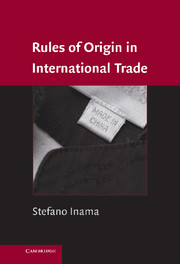Book contents
- Frontmatter
- Contents
- List of Figures
- List of Tables
- List of Acronyms
- Preface
- 1 Efforts to Establish Multilateral Rules
- 2 The Uruguay Round Agreement on Rules of Origin: The Harmonization Work Program of Nonpreferential Rules of Origin
- 3 Preferential Rules of Origin
- 4 The Economics of Rules of Origin
- 5 Drafting Preferential Rules of Origin
- 6 The Administration of Rules of Origin
- Index
1 - Efforts to Establish Multilateral Rules
Published online by Cambridge University Press: 18 August 2009
- Frontmatter
- Contents
- List of Figures
- List of Tables
- List of Acronyms
- Preface
- 1 Efforts to Establish Multilateral Rules
- 2 The Uruguay Round Agreement on Rules of Origin: The Harmonization Work Program of Nonpreferential Rules of Origin
- 3 Preferential Rules of Origin
- 4 The Economics of Rules of Origin
- 5 Drafting Preferential Rules of Origin
- 6 The Administration of Rules of Origin
- Index
Summary
Rules of origin have long been considered a rather technical customs issue, with little bearing on trade and economic policy. However, origin has far-reaching implications, not only for trade policy but also for domestic disciplines regulating the marketing of products to final consumers. Marks of origin, linkages with geographical denomination, or the definition of “domestic industries” may not be directly linked to the traditional view of origin limited to a border control device. The relevance of rules of origin (a “secondary trade policy instrument”) may be fully grasped only when they are associated with primary trade policy instruments that they support, such as tariffs, contingency protection measures, and trade preferences.
Rules of origin are often associated with preferential trade regimes, as the fulfillment of origin criteria is a precondition for the application of a preferential tariff. Nonpreferential rules of origin apply to trade flows that do not benefit from tariff or other trade preferences. One of the main differences between nonpreferential and preferential rules of origin is that the former should always provide for an exhaustive method to determine origin. In the case of preferential rules of origin, if the origin criterion is not met, the preferential tariff will not be applied. Unless there are more than two parties involved in a preferential tariff treatment, there is often no need to fall back on alternative methods to secure an origin outcome.
- Type
- Chapter
- Information
- Rules of Origin in International Trade , pp. 1 - 16Publisher: Cambridge University PressPrint publication year: 2009



